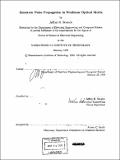| dc.contributor.advisor | Jeffrey H. Shapiro. | en_US |
| dc.contributor.author | Bounds, Jeffrey Keith | en_US |
| dc.date.accessioned | 2005-06-02T15:22:51Z | |
| dc.date.available | 2005-06-02T15:22:51Z | |
| dc.date.copyright | 1999 | en_US |
| dc.date.issued | 1999 | en_US |
| dc.identifier.uri | http://hdl.handle.net/1721.1/17473 | |
| dc.description | Thesis (Sc.D.)--Massachusetts Institute of Technology, Dept. of Electrical Engineering and Computer Science, 1999. | en_US |
| dc.description | Includes bibliographical references (p. 393-399). | en_US |
| dc.description.abstract | Good quantum mechanical descriptions of noise evolution with propagating optical waves are critical to understanding the processes which currently limit the generation of squeezed radiation in nonlinear materials. In the first part of this dissertation a general quantum optical model is developed from fundamental principles to describe optical propagation in a broad variety of nonlinear media. The central distinction of the resulting Quantum Macroscopic Propagation Model ( QMPM) is that material susceptibilities, representing the field's interaction with matter, are replaced with quantum mechanical operators. These quantum material operators are shown to comprise material response functions corresponding to the semiclassical susceptibilities and material noise operators representing the true quantum mechanical nature of the material. The material noise operators play important roles in the noise evolution of propagating fields. The Quantum MacrQscopic Propagation Model is compared with the Langevin techniques of statistical mechanics and is shown to correspond to a quasi-rigorous generalized quantum Langevin model. The QMPM correctly indicates the form of the noise operators associated with any particular order of nonlinearity. In the second part a specific model for squeezing in fiber is developed from the general QMPM. Dispersion, linear loss, Raman scattering, forward Brillouin scattering (GAWBS), and two-photon absorption are incorporated into the model, which is linearized and solved for the continuous-wave case. The model successfully predicts several interactions between nonlinearity, dispersion, and noise. It is shown that low levels of two-photon absorption resulting from germanium-doping of fiber may impose critical limits on fiber squeezing. Forward Brillouin scattering is shown to behave exactly as low-frequency Raman scattering and to seriously limit fiber squeezing at low frequencies. The cw composite model is applied to the parameters of several fiber squeezing experiments described in the literature, and the model is shown to predict with fair accuracy the squeezing results in most cases, including soliton squeezing when Lai's effective soliton nonlinear phase shift is used as the phase shift parameter for the model. Simplified expressions are obtained relating the optimal squeezing available to the nonlinear parameters of a particular experiment or new material. | en_US |
| dc.description.statementofresponsibility | by Jeffrey K. Bounds. | en_US |
| dc.format.extent | 399 p. | en_US |
| dc.format.extent | 18887790 bytes | |
| dc.format.extent | 18887591 bytes | |
| dc.format.mimetype | application/pdf | |
| dc.format.mimetype | application/pdf | |
| dc.language.iso | eng | en_US |
| dc.publisher | Massachusetts Institute of Technology | en_US |
| dc.rights | M.I.T. theses are protected by copyright. They may be viewed from this source for any purpose, but reproduction or distribution in any format is prohibited without written permission. See provided URL for inquiries about permission. | en_US |
| dc.rights.uri | http://dspace.mit.edu/handle/1721.1/7582 | |
| dc.subject | Electrical Engineering and Computer Science | en_US |
| dc.title | Quantum noise propagation in nonlinear optical media | en_US |
| dc.type | Thesis | en_US |
| dc.description.degree | Sc.D. | en_US |
| dc.contributor.department | Massachusetts Institute of Technology. Department of Electrical Engineering and Computer Science | |
| dc.identifier.oclc | 42427313 | en_US |
